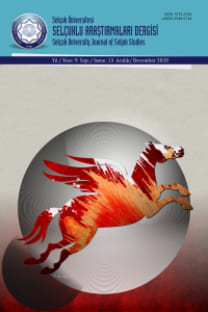BÜYÜK SELÇUKLULAR VE HÂREZMŞAHLAR DEVRİNE AİT AZ BİLİNEN BİR KAYNAK: CEVÂHİR-NÂME-Yİ NİZÂMÎ
Cevâhir-nâme-yi Nizâmî, , Büyük Selçuklular, , Hârezmşahlar, , İran, , cevâhir-nâme.
JAWĀHER-NĀMA-YE NEZĀMĪ: A LITTLE-KNOWN SOURCE OF THE GREAT SALJUQS AND KHWĀREZMSHAHS
Jawāher-nāma-ye Nezāmī, Great Saljuqs, Khwārezmshahs, Iran, jawāher-nāma.,
___
- ‘Abdullah Kâşânî, ‘Ara’isu’l-cevâhir ve nefâ’isu’l-atâ’ib, neşr. İrec Afşâr, Tahran 1385/2006.
- Dankoff, Robert, “A Note on Khutū and Chatuq”, Journal of the American Oriental Society, 93/4, 1973, s. 542-543.
- Ebû’r-Reyhân Bîrûnî, el-Cemâhir fî’l-cevâhir, nşr. Yûsuf el-Hâdî, Tahran 1374/1995; Kıymetli Taşlar ve Metaller Kitabı, Türkçe terc. Emine Sonnur Özcan, Ankara 2017.
- Ekber Haydaryân, “Tashîh u bâz-hânî-yi ‘ibârâtî ez-Cevâhir-nâme-yi Nizâmî”, Gozâriş-i Mîrâs, 78-79, 1396/2017, s. 183-186.
- Eliaçık, Muhittin, “Şaban Efendi’nin Şifâ’iyye Risalesinde İnci Üzerine Açıklamalar”, The Journal of Academic Social Science Studies, 5/6, 2012, s. 189-203.
- ___________, “Şifâ’iyye Adlı Esere Göre Dağ Keçisi ve Yılanda Panzehir Özellikli Taşlar”, İdil, 1/5, 2012, s. 8-31.
- Hinz, Walther, İslâm’da Ölçü Sistemleri, Türkçe trc. Acar Sevim, İstanbul 1990.
- Afşâr, İrec, “Cevher-nâme-yi Nizâmî mehz-i Tensûh-nâme u ‘Ara’isu’l-cevâhir”, Yagmâ, 271, 1350/1971, s. 35-42.
- Kallek, Cengiz, “Men”, DİA, XXIX, İstanbul 2004, s. 105-107.
- Manouchehr Moshtagh Khorasani-Niko Hynninen, “Reproducing Crucible Steel: A Practical Guide and A Comparative Analysis to Persian Manuscripts”, Gladius, XXXIII, 2013, s. 157-192.
- Menûçehr Moştâk-i Horâsânî, “Tabaka-bendî-yi fûlâd-i cevher-dâr ber-esâs-i nushehâ-yi hattî”, Mecelle-yi Mutâla‘ât-i İrânî, 18, 1389/2010, s. 243-282.
- Mihrnûş Şafî‘î-yi Serârûdî-Zehra Muhtârî-Yûsuf Emînî, “Bâz-sâht-i lo‘âb-i mînâî ber-esâs-i metn-i Cevâhir-nâme-yi Nizâmî”, Neşriyye-yi Hunerhâ-yi Zîbâ-Hunerhâ-yi Tecessumî, XXII/IV, 1396/2017, s. 33-42.
- Muhammed b. Ebî el-Berekât Cevherî-yi Nîşâbûrî, Cevâhir-nâme-yi Nizâmî, nşr. İrec Afşâr, Tahran 1383/2004.
- Nâsiru’d-dîn-i Tûsî, Tensûh-nâme-yi İlhânî, nşr. Takî Muderris-i Rezevî, Tahran 1348/1970.
- Porter, Yves, “Jawāher-nāma”, Encyclopaedia Iranica, XIV, fasc. VI, 2008, s. 609-610.
- __________, “Les Techniques du Lustre Métallique d’apres le Jowhar-nāme-ye Nezāmi (1196 AD)”, VIIe Congrès International sur la Céramique Médiévale en Méditerranée, Athènes 2003, s. 427-436.
- ___________, “Le Quatriѐme Chapitre du Javāher-nāme-ye Neẓāmī”, Sciences, Techniques et Instruments dans Le Monde Iranien (Xᵉ-XIXᵉ Siѐcle), ed. N. Pourjavady-Ž. Vesel, Téhéran 2004, s. 341-360.
- Qiu Yihao, “A Resurvey of the Khutū (Rhinoceros Horns or Walrus Ivory) based on Western and Eastern Accounts”, Shehui kexue zhanxian, 2, 2018, s. 129-142 (Çince).
- Ruska, Julius, “Noch einmal al-Chutww”, in Kleine Mitteilungen und Anzeigen, Der Islam, 4/1, 1913, s. 163-164.
- Seyyid Cevâd Murtezâ’î-Ekber Haydaryân, “Tashîh u bâz-hânî-yi ‘ibârâtî ez-Cevâhir-nâme-yi Nizâmî”, Pejûheş-nâme-yi Nushe-şinâsî-yi Metûn-i Nezm u Nesr-i Fârsî, IV, 1396/2017, s. 53-74.
- Seyyid Muhammed Mîr-Şafî‘î-Mehdî Muhammedzâde, “Fenn-şinâsî u sâht-i mînâ-yi zerrîn-fâm-i şîşe ber-esâs-i formulhâ-yi kitâb-i Cevâhir-nâme-yi Nizâmî”, Pejûhe-yi Bâstân-Sencî, II, 1394/2015, s. 27-38.
- ___________, “Sâht-i lo‘âb-i zerrîn-fâm-i İrânî ber-esâs-i kitâb-i Cevâhir-nâme-yi Nizâmî”, Neşriyye-yi Hunerhâ-yi Zîbâ-Hunerhâ-yi Tecessumî, XX/I, 1394/2015, s. 59-66.
- Şeşen, Ramazan, “Türkiye Kütüphanelerindeki Tanıtılmamış Bazı Farsça Yazmalar”, İslâm Tetkikleri Dergisi, VIII/1-4, 1984, s. 5-70; “Berhî ez-nuseh-i hattî-yi nâşinâhte-yi Fârsî der-kitâbhânehâ-yi Turkiye”, Farsça trc. Tevfîk Subhânî, Tahkîkât-i İslâmî, V-VI, 1366/1987, s. 170-184.
- Yûsuf Bîg Bâbâpûr, “Cevâhir-nâme-nevîsî der-dovre-yi İslâmî”, Kitâb-i Mâh-i ‘Ulûm u Funûn, 1388/2009, s. 70-81.
- Ž. Vesel-I. Afshar-P. Mohebbi, “«Le Livre des Pierres pour Nezām [al-Molk] (Javāher-nāme- ye Nezāmī)» (592/1195-6): lasource présumée du Tansūkh-nāme-ye Īlkhānī de Tūsī”, Bibliothèque Iranienne (Nasīr al-Dīn Tūsī, philosophe et savant du XIIIe siècle), 54, ed. N. Pourjavady-Ž. Vesel, 2000, s. 145-174.
- ISSN: 1015-2105
- Yayın Aralığı: Yılda 2 Sayı
- Başlangıç: 1986
- Yayıncı: Selçuk Üniversitesi
XII. YÜZYIL BİZANS ANADOLUSU’NDA KENTSEL EKONOMİ: TEMEL DİNAMİKLER VE PERGAMON ÖRNEĞİ
BÜYÜK SELÇUKLULAR VE HÂREZMŞAHLAR DEVRİNE AİT AZ BİLİNEN BİR KAYNAK: CEVÂHİR-NÂME-Yİ NİZÂMÎ
BÜYÜK SELÇUKLULAR DÖNEMİ’NDE HEMEDAN’IN SİYASİ TARİHİ
ARAPÇA TARİH KAYNAKLARININ TERCÜME PROBLEMİNE BİR ÖRNEK: İBN KALÂNİSÎ ŞAM TARİHİNE ZEYL
ANADOLU’DAKİ BİZANS THEMA BİRLİKLERİNİN MALAZGİRT ÖNCESİ VAZİYETLERİ: UMUMÎ BİR İNCELEME
